How to Catch a Mermaid Activities and Lesson Plan
If you’re searching for how to catch a mermaid activities to use in speech therapy, you’re in the right place!
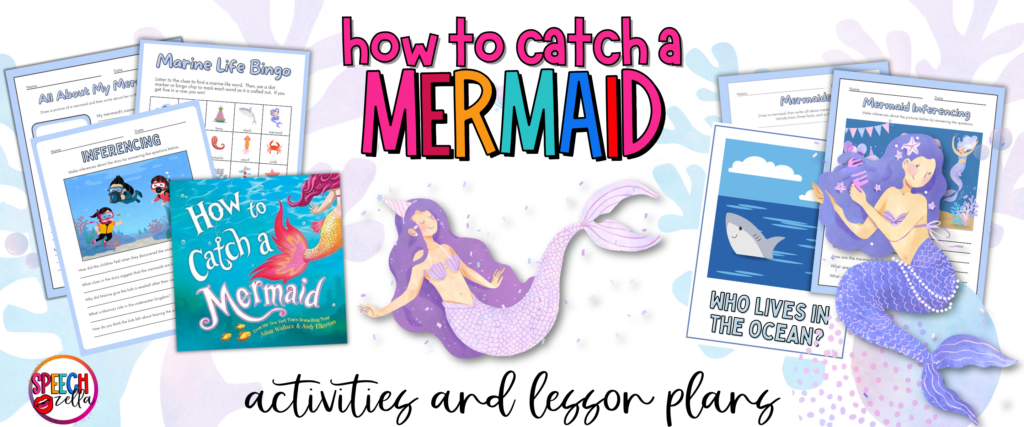
Figuring out ways to stretch a book beyond simple wh- questions can be tricky. So, that’s why I have created 10+ free book companion activities that you can use in your speech room today with both elementary and middle school students. Keep reading to get all the links!
How to Catch a Mermaid Activities
I created a speech therapy bundle of activities that pairs perfectly with How to Catch a Mermaid. These book companions cover everything from narrative language to inferencing—keeping kids engaged while you target their speech-language therapy goals.
Activities include:
- Mermaid Story Retell Map — Students read a short story and then practice sequencing and story grammar with the included flashcards.
- Marine Life Compare & Contrast — Students choose two ocean creatures and then build expressive language by comparing and contrasting.
- Mermaid Conversation Comic Strip — If you want to tackle social skills like greetings, asking questions, and turn-taking, check out this fun comic strip.
- Mermaid Inferencing Worksheet — Students will ready a fictional story, then answer questions about the story, make inferences, and define words based on context clues.
- Vocabulary Flashcards — If you need to improve word retrieval, these matching vocabulary cards are perfect for your students.
- Marine Life Bingo — Students listen to a short riddle and then figure out the matching vocabulary word.
- All About My Mermaid Descriptive Writing — Students draw a mermaid then practice describing the mermaid they drew.
- The History of Mermaids Nonfiction Reading — This higher-level reading passage for middle school students explains the history of mermaids while targeting reading comprehension.
- Design a Mermaid Trap – Your students can plan a mermaid trap, then write or draw about their design.
- Mermaid Adaptations – If mermaids really existed, how would they survive the ocean habitat? This activity is great for pairing science and speech therapy!
How to Catch a Mermaid Book
How to Catch a Mermaid by Adam Wallace and Andy Elkerton is an awesome book that pulls students into an underwater world of adventure. It’s been featured in popular media outlets like the New York Times and USA Today, so you should check it out today!
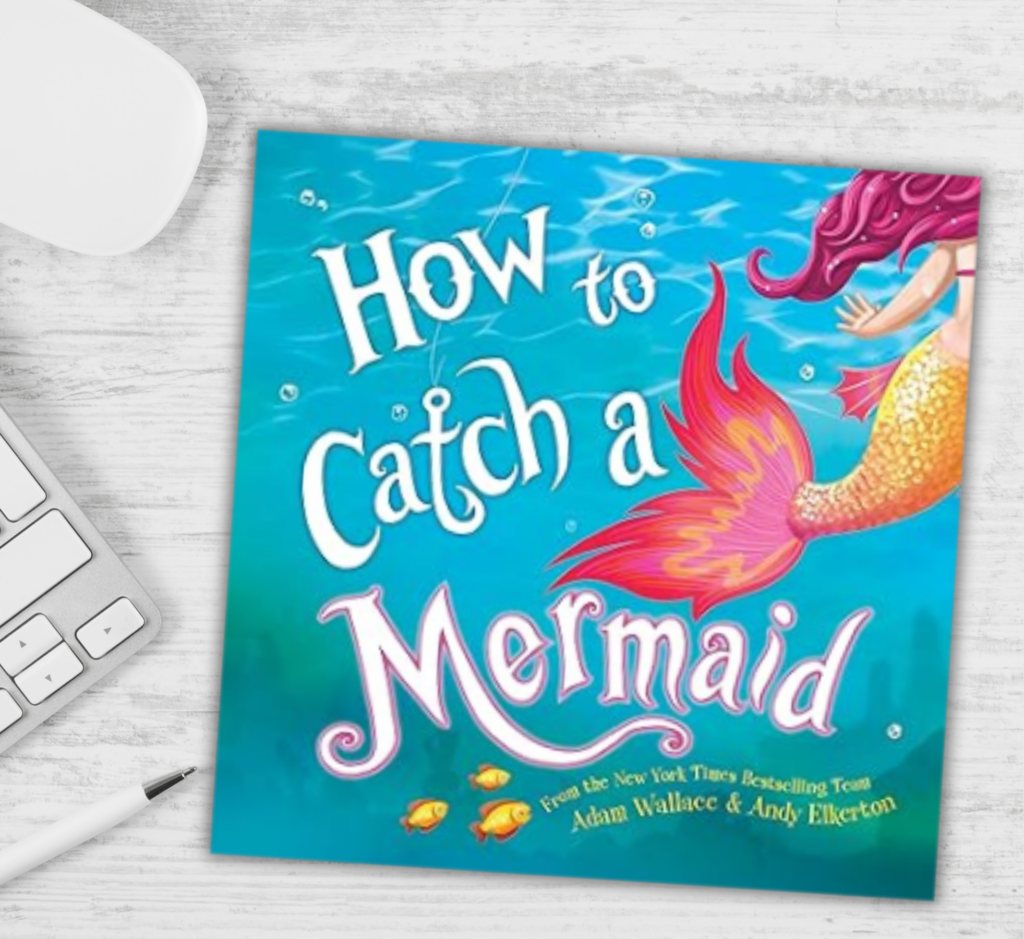
Free Resource Library for Canva SLPs
If you want to check out all the free activities in my resource library, sign up for my newsletter.
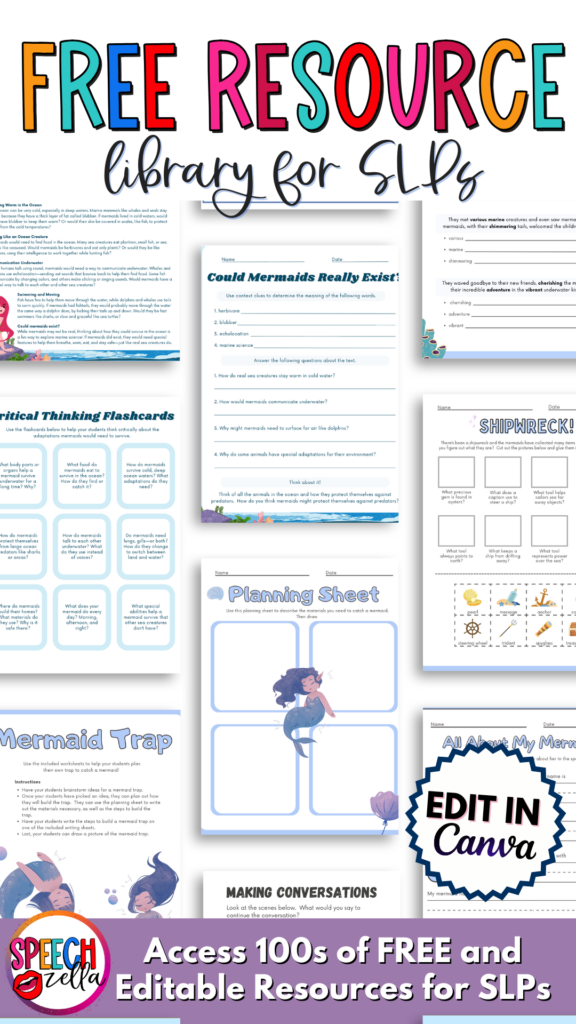
When you submit the form, you'll receive my mermaid lesson plans that outlines all the included activities and how to use them in your speech room!
Additionally, you'll get access to over 1000 other Canva templates that target language, articulation, executive function and more!
What’s Included?
This lesson plan will give you everything you need to implement these activities in your speech room today! You’ll get:
- wh- comprehension questions
- vocabulary list
- suggested games / activities
- links to all the free Canva templates!
If you're not sure how to use Canva for Education, check out my blog post: How to Use Canva for Education.
How Do You Catch Mermaids?
The book follows a group of kids as they brainstorm ways to catch a mermaid. They build traps, set up obstacles, and get creative —which is perfect for prompting students to generate their own ideas to catch a mermaid.
If you don’t have a copy of the book, you can check out this YouTube video:
You can even share your activities with the English language arts teacher to help them make educational fun materials.
Mermaid Trap
Have each child brainstorm and describe mermaid traps using the descriptive writing template below. There are 4 worksheets included in this template set:
- Brainstorming: Your students can write different kinds of mermaid trap plans.
- Planning: Students can use this worksheet to plan out their idea (e.g., materials, steps).
- 2 Writing worksheets: Choose a worksheet so your students can write out the steps for trapping a mermaid.
You can even have students design a mermaid page, complete with illustrations and fun facts about their favorite magical creatures.
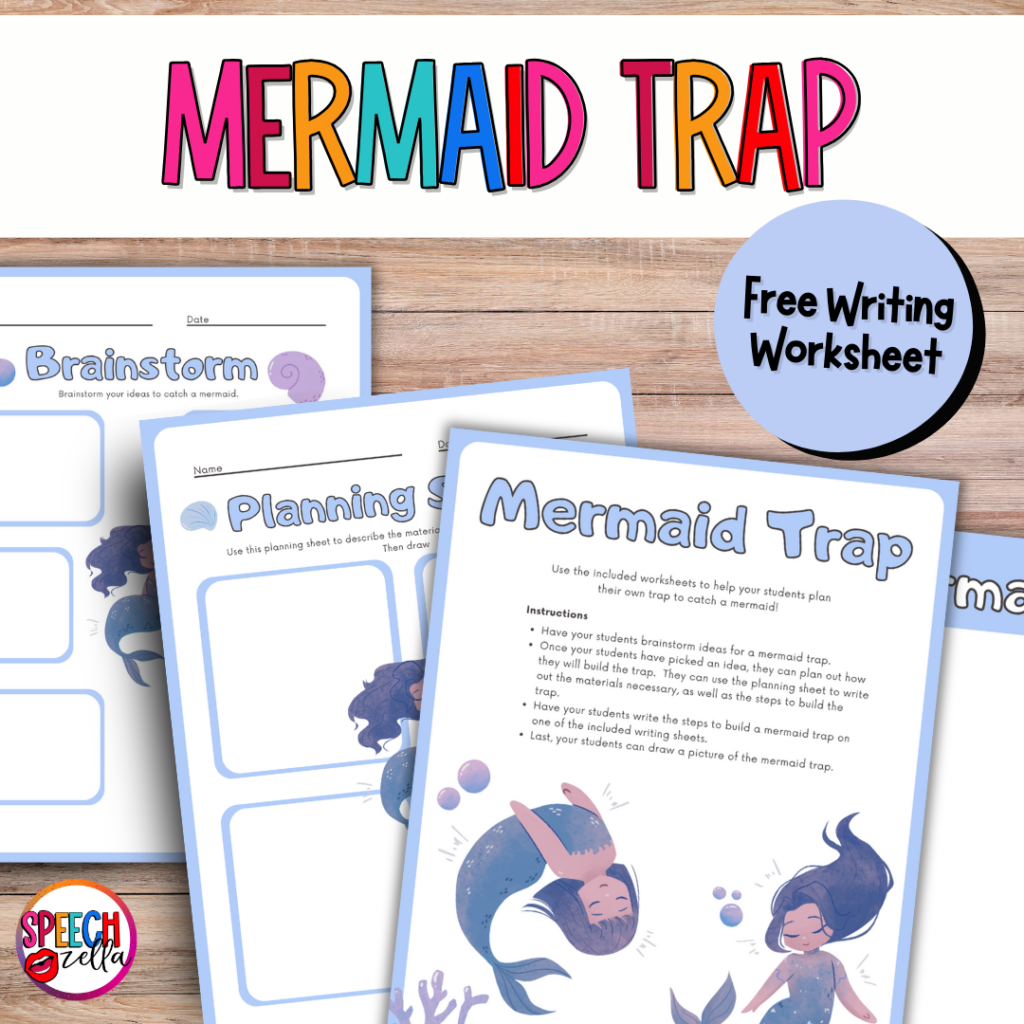
Tips: They can add stickers of treasure chests or gold to their plans because every mermaid needs a little treasure! Maybe your mermaid-catching team can devise a plan to outsmart an extra speedy mermaid!
How Can You Meet a Mermaid?
This question is a fun way to target WH questions and perspective-taking. Use the comic strip activity or start a conversation about what students would say if they met a mermaid.
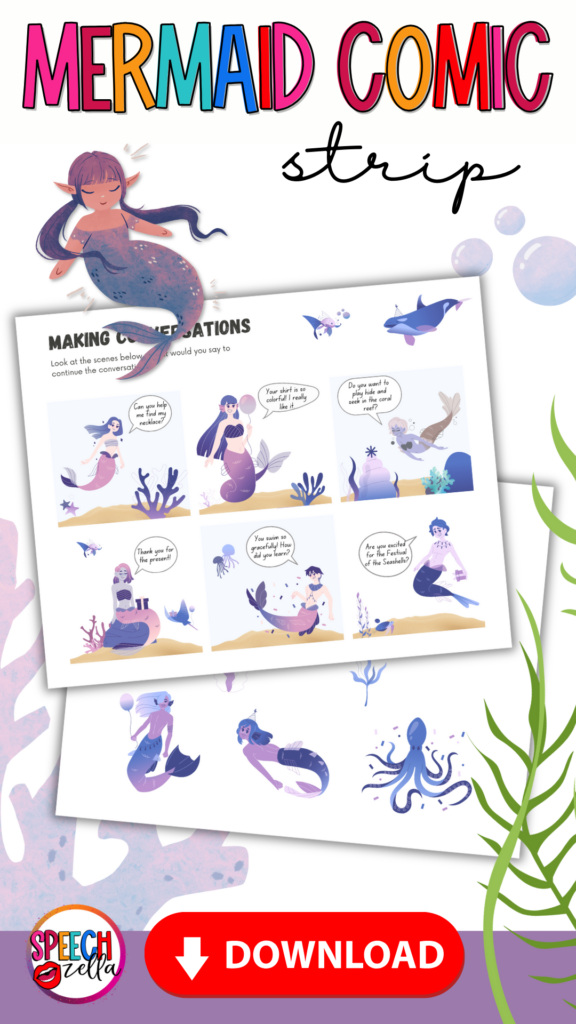
Mermaid Conversation Strip
This is a great activity to target social skills, such as practicing greetings, asking questions, and making comments.
Your student can even change the conversation to anything they like – so that's where their imagination soars.
Students can write about what they would do if they swam alongside mermaids. Or what they would do if they ever met a mermaid.
Where Are Mermaids Usually Found?
Use this as a jumping-off point for compare/contrast work or descriptive language. Mermaids live in oceans, coral reefs, and sometimes magical underwater cities, so learn more about the ocean animals around them!
The Marine Life Compare & Contrast activity helps students visualize the underwater world of adventure, complete with hidden treasure chests waiting to be discovered.
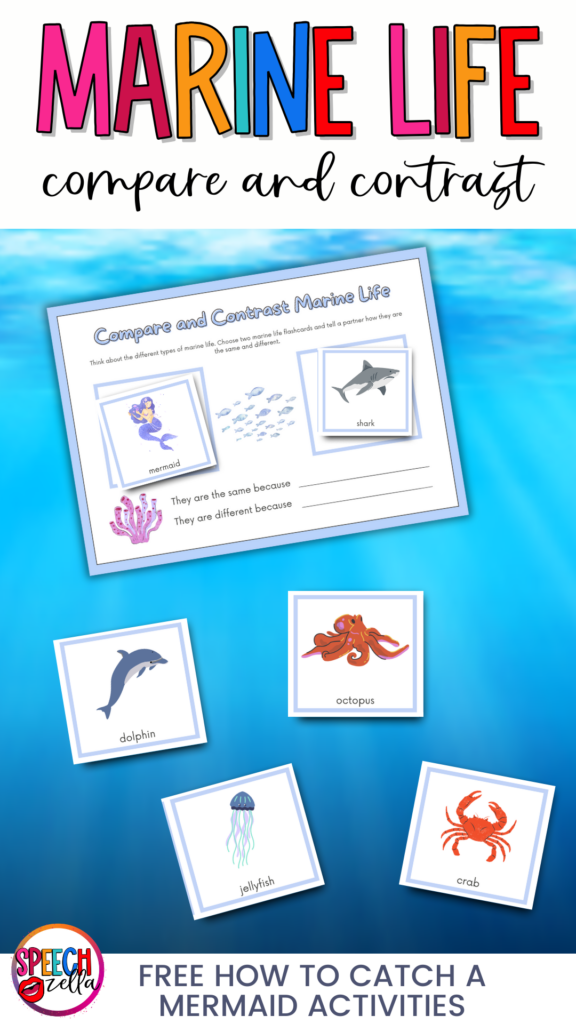
Activity Overview: Students pick two marine animals to compare and contrast using the worksheet.
Speech Room Use: Comparing and contrasting helps students develop descriptive language skills.
Speech pathologists can use this activity to encourage students to use comparative language (e.g., bigger, smaller, more colorful) and descriptive sentences.
Share this activity with your child's teacher to extend learning.
How to Catch a Mermaid Craft
End your session with a mermaid craft! Pair it with the All About My Mermaid activity, where students draw their mermaid, describe her powers, and create their own mermaid.

Activity Overview: Students use this worksheet to describe a mermaid they drew.
Speech Room Use: This writing activity helps students practice narrative skills and sentence formation. This activity includes sentence starters to support students who struggle with writing. This also allows for practice in sequencing and organizing thoughts. Students can go ahead and make their imagination soar!
How to Catch a Mermaid Activities for Kindergarten
Kindergarten students love interactive, hands-on activities! These unicorn lovers also love mermaids!
Mermaid Story Retell Map
Use the Mermaid Story Retell Map with picture supports to practice sequencing. Two short stories are included in this activity.
Choose a story, then have your students put the story cards in the correct order. Have them explain all the steps verbally while using transition words (i.e., first, then, next)
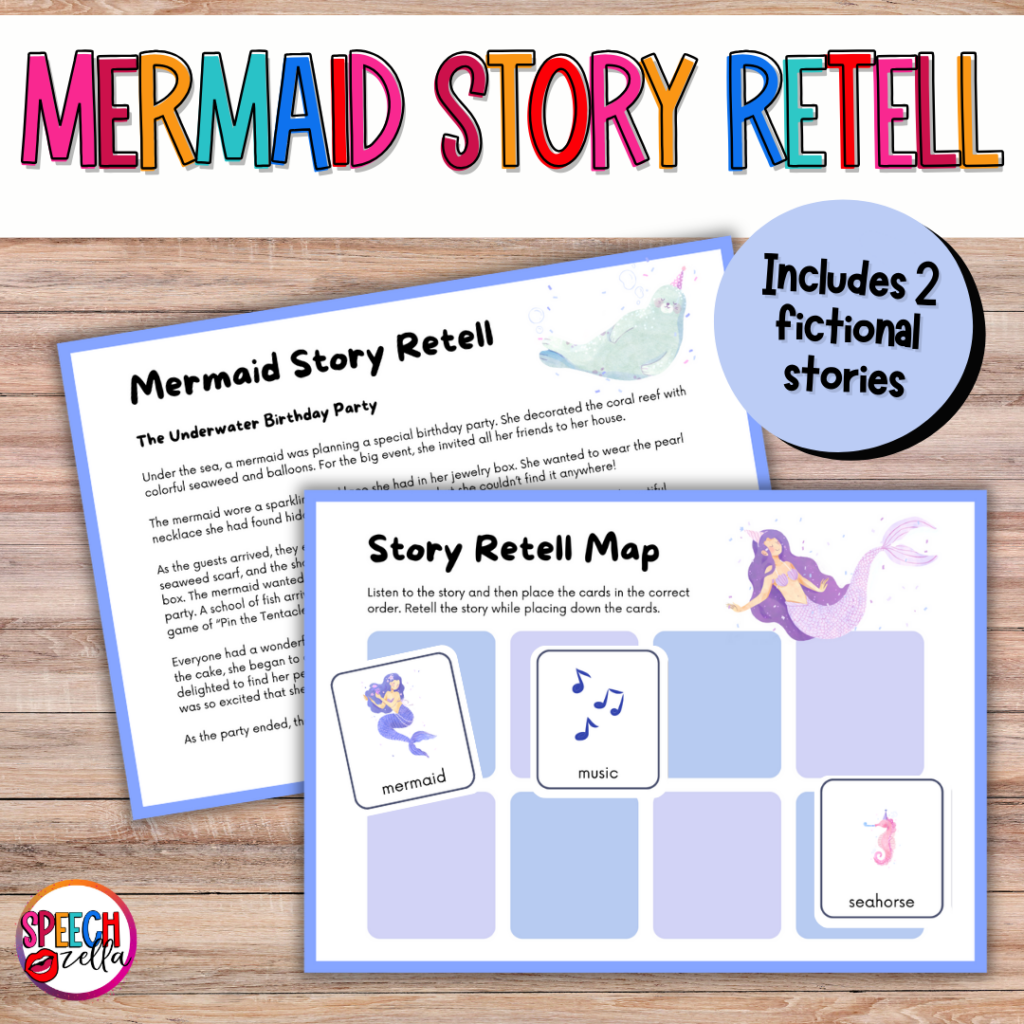
Marine Life Bingo Game
Then, play the Marine Life Bingo Game to work on listening and vocabulary in a fun, game-based way that keeps children engaged and learning.
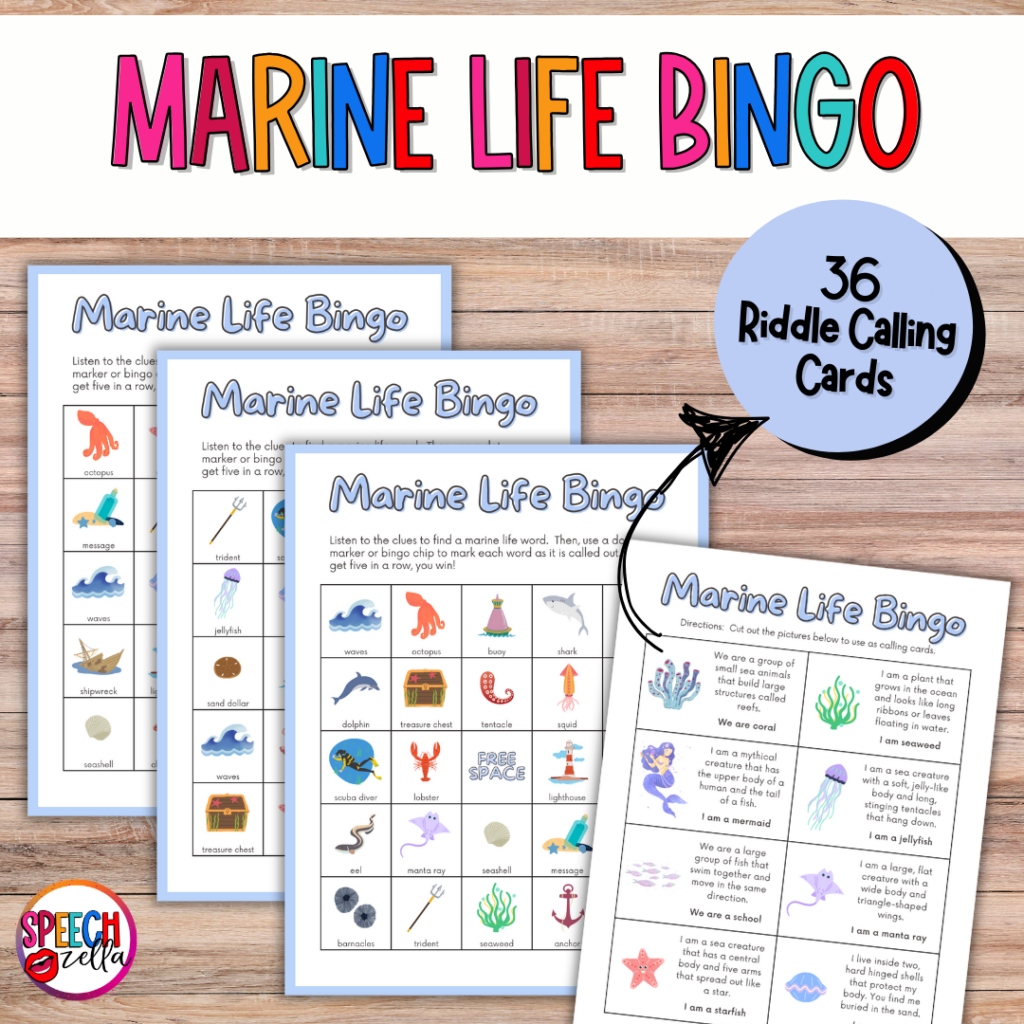
Mermaid Vocabulary Flashcards
The Mermaid Vocabulary Flashcards are perfect for little ones building early language skills. These activities spark creativity and help every child feel successful.
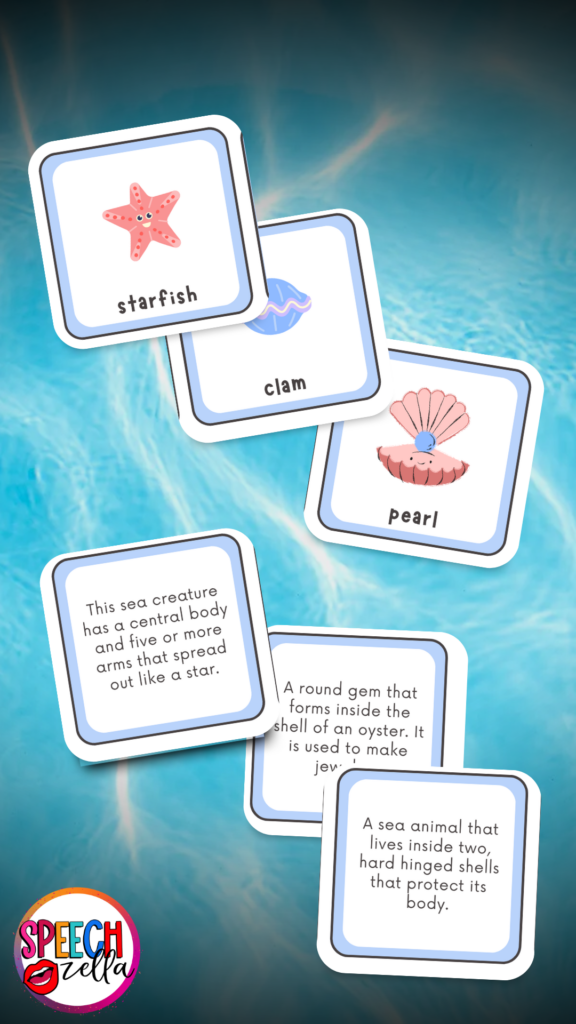
Activity Overview:
Introduce the students to the vocabulary related to mermaids and marine life.
You can also play a memory game or match the definitions to the vocabulary words.
Speech Room Use
This activity helps students with vocabulary acquisition and word association.
Discuss each word's definition and have students use the words in sentences.
How to Catch a Mermaid Activities for Older Students
Older elementary students also love talking about mythical creatures, especially mermaids. Check out these Canva templates that target reading comprehension, inferencing, context clues, vocabulary, and more with your older students.
Mermaid Reading Comprehension Workbook
This activity includes a mermaid reading comprehension passage, along with activities to target vocabulary building, inferencing, wh- questions, and writing.
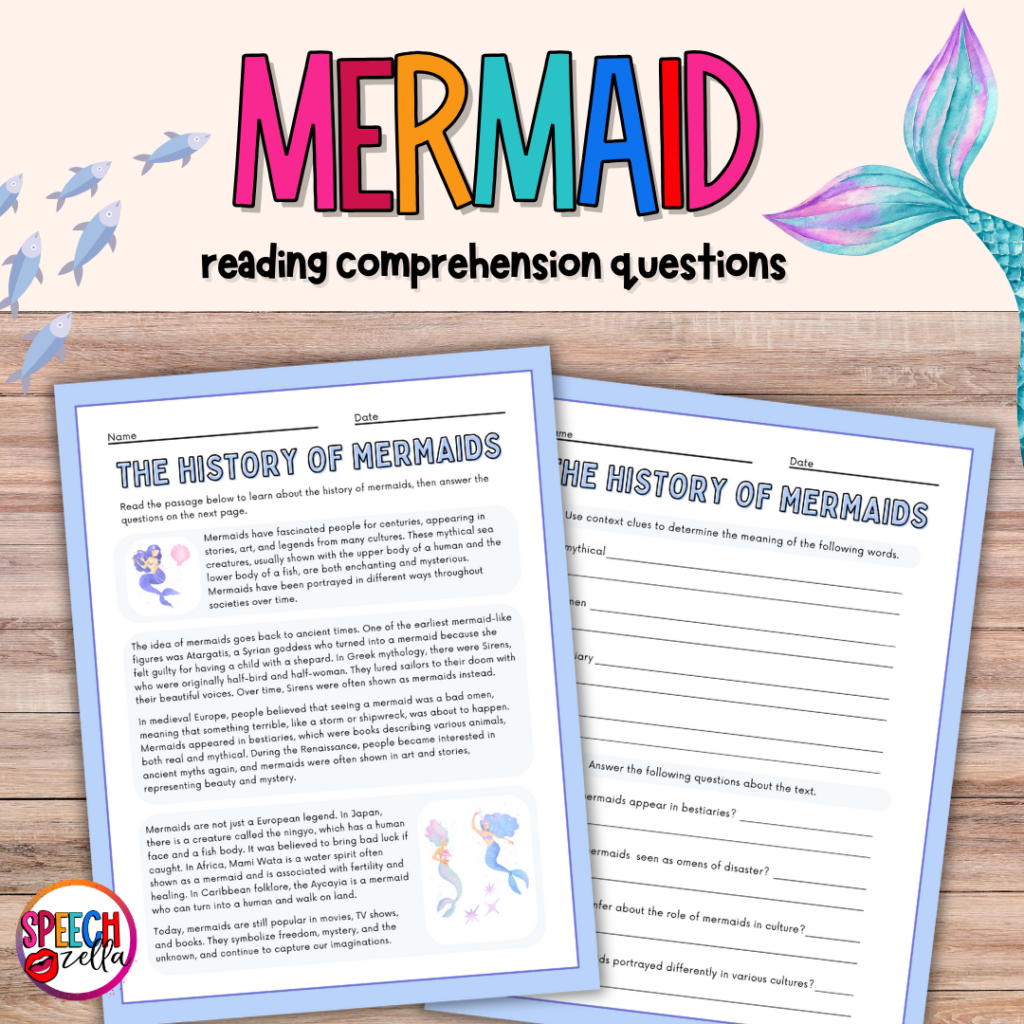
Build reading comprehension through defining words via context clues and answering inferencing questions.
Mermaid Inferencing Workbook
Students in grades 3 to 5 can read a short fictional story about three children who discover an underwater kingdom. Check out this all new activity book!
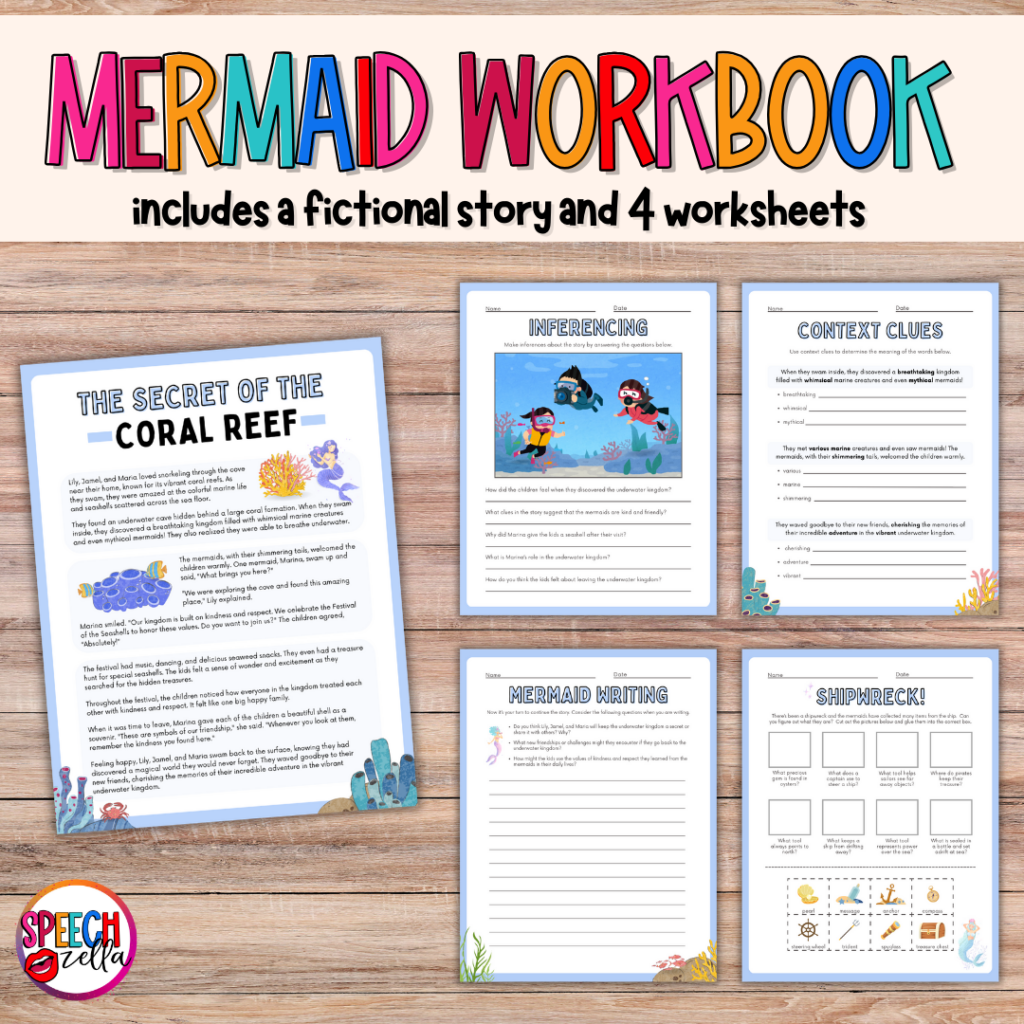
After reading the story about an undersea adventure, students complete four language-based worksheets that build critical thinking and communication skills:
- Context Clues – Use clues in the story to figure out the meaning of unfamiliar words.
- Inferencing – Make logical guesses based on what characters say and do with these comprehension questions.
- Vocabulary – Match story vocabulary to definitions in a “guess that word” activity.
- Writing (optional)– Students will respond to a writing prompt and support their answers with evidence from the text.
Mermaid Adaptations
If mermaids really existed, how would they adapt to the ocean? This reading comprehension worksheet explores how mermaids could adapt to ocean conditions by exploring how other marine animals already adapt to their habitat.
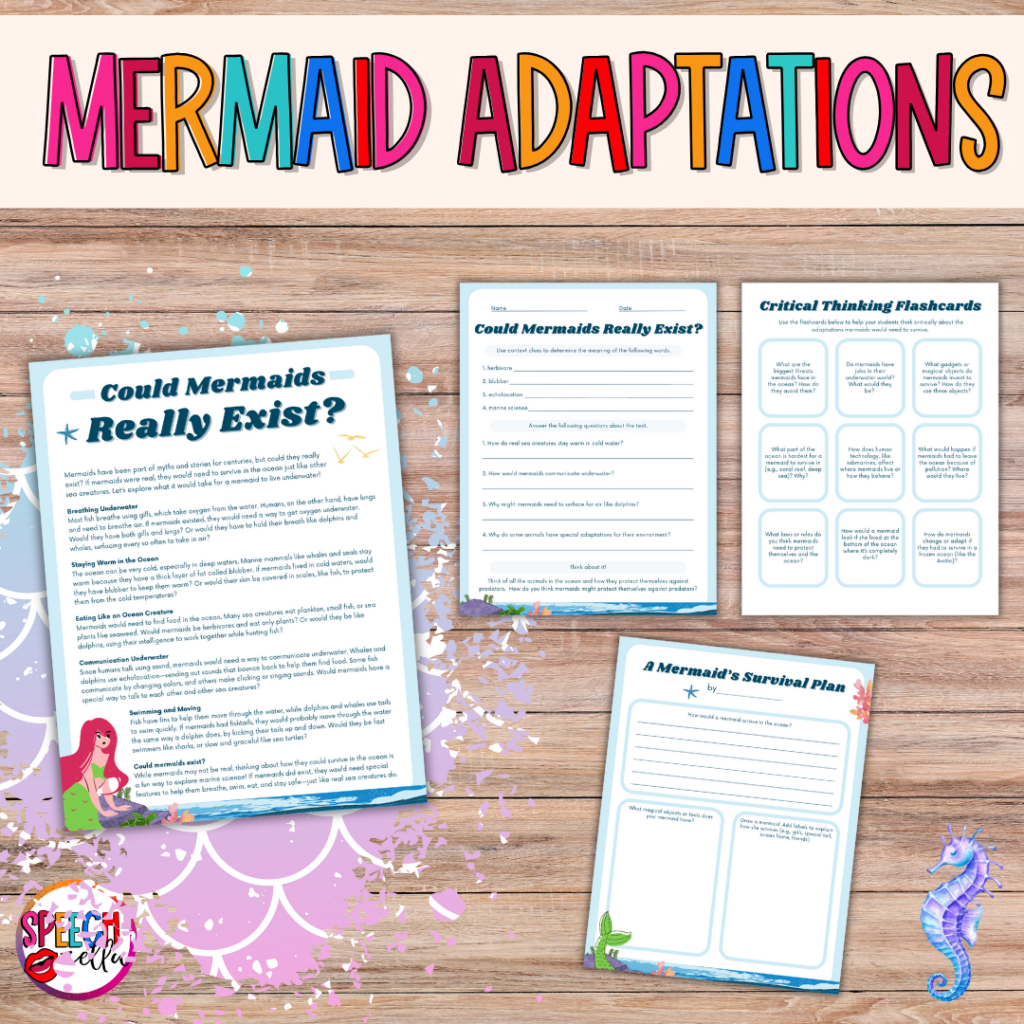
This interactive workbook combines science fiction with real-world marine concepts. Students will read a nonfiction passage exploring what mermaids need to survive in the ocean—based on real animal adaptations.
From gills to echolocation, the reading gives students a fun way to think critically while learning new vocabulary.
The workbook includes:
- Informational Reading Passage – A science-based non-fictional read that explores how mermaids could exist.
- Vocabulary & Comprehension Page – Context clues, reading questions, and an open-ended “Think About It” question.
- Critical Thinking Flashcards – 18 higher-level questions that challenge students to analyze, imagine, and explain survival strategies.
- A Mermaid’s Survival Plan Worksheet – These mermaid writing templates help students creatively explain how their mermaid lives in the ocean (with a place to draw and label adaptations).
This summer activity is perfect for group and independent work to improve vocabulary, inferencing, expressive language, and higher-order thinking skills.
Why Speech Therapists Love Book Companions
Pairing books like How to Catch a Mermaid with speech therapy targets is my favorite activity in therapy sessions.
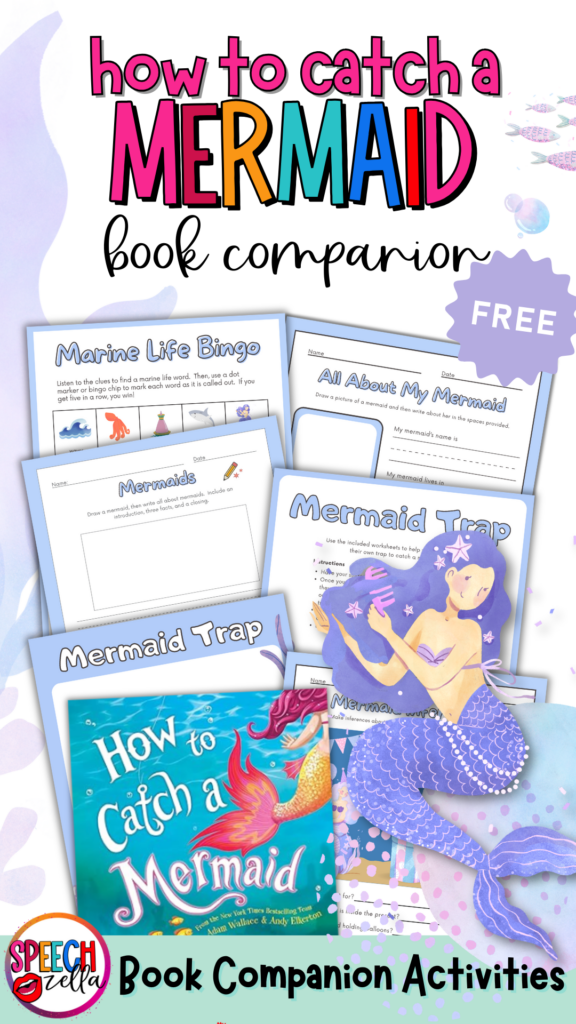
When you use book companions, It keeps sessions structured, gives kids context, and provides built-in visuals.
Additionally, adding interactive workbooks and boom cards makes everything easy to adapt for groups, individuals, or virtual sessions.
With these mermaid-themed activities, you can sneak in grammar practice, narrative retelling, describing, and also articulation.
These exciting activities easily tie into other books—like your favorite unicorn activity book— and also fit into 2nd grade ELA standards.
Summer activities for SLPs
There are so many activities we can use to help our students improve their language skills in the summer. If you want to read more about summer activities I created in Canva, then check out these other blog posts!
